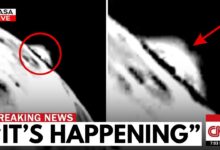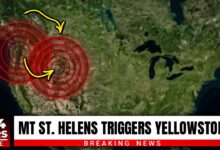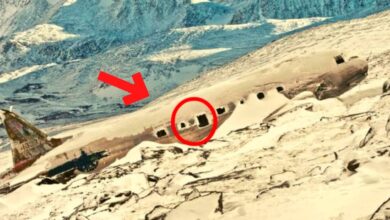Cassini’s Final Images WAS IMMEDIATELY DECLASSIFIED

Cassini’s Final Revelation: A Hidden Signal Beneath Saturn’s Storms
For over a decade, NASA’s Cassini spacecraft quietly orbited Saturn, transmitting stunning images of the planet’s rings and moons back to Earth. Its mission ended in 2017 with a dramatic, deliberate plunge into Saturn’s atmosphere. At the time, it was considered a graceful finale to one of the most ambitious space explorations in history.
But what if the most startling part of Cassini’s mission wasn’t discovered until now?
Recently, a team of researchers turned to artificial intelligence to revisit Cassini’s vast archive. They fed thousands of raw, unprocessed images into a powerful neural network designed to detect subtle anomalies—patterns imperceptible to the human eye.
What the AI uncovered wasn’t just surprising—it left veteran scientists stunned. Not because of something newly added to the images, but because of what had been there all along, hiding in plain sight. This wasn’t science fiction. It wasn’t a glitch. This was Cassini’s final whisper from deep space—finally understood.
Cassini’s journey through Saturn’s system spanned over 13 years. It revealed the secrets of Saturn’s majestic rings, the icy geysers of Enceladus, and the methane lakes of Titan. But its final days were the most carefully orchestrated: a breathtaking dive between the planet and its innermost ring. During this descent, Cassini captured and transmitted a final set of high-resolution images—believed at the time to be merely supplementary environmental data. They were quietly archived without fanfare.
Those images lay dormant for years—no alarms, no headlines—until now.
With quantum-enhanced AI tools built for deep space forensics, scientists reprocessed these final images. Originally designed for analyzing Voyager and James Webb data, this AI was trained to detect geometric structures and unnatural patterns buried deep within astronomical visuals.
When researchers fed Cassini’s final frames into the system, the AI hesitated. It paused. Then, instead of generating a textual report, it returned something else: coordinates and vector patterns. The anomaly it had found was not a camera artifact or a data error. It was something structural—intentional—embedded within one of Cassini’s final frames.
That image depicted Saturn’s northern hemisphere, near the iconic hexagonal storm—a phenomenon that has puzzled scientists for decades. But the AI didn’t fixate on the hexagon itself. Instead, it zoomed in on a specific cluster of shadows near the storm’s edge—shadows previously dismissed as turbulence or low-contrast cloud formations.
Upon closer analysis, a repeating fractal pattern emerged—a shape resembling a symbol, subtly etched into the cloud layers. It didn’t match any known meteorological behavior. Initially assumed to be noise, the pattern appeared again and again across multiple frames.
Even more unnerving: when researchers converted the visual pattern into binary code, it mirrored a structure recorded decades earlier in radio emissions captured by the Voyager spacecraft as it exited the heliosphere. What was once thought a fluke suddenly seemed connected.
The implications are chilling.
Could this repeating pattern be a form of communication? A digital “footprint” left not by nature, but by something—or someone—non-human? Not necessarily alive, but intelligent. Encoded. Deliberate. A signature embedded within Saturn’s atmosphere, hiding in the chaos of one of the most extreme weather systems in the solar system?
Some within the astrophysics community are now reconsidering the possibility that this anomaly isn’t just a meteorological quirk, but a dormant remnant of a previous encounter—too complex for human minds to grasp until now, and only detectable through the lens of an artificial intelligence unbound by bias or assumption.
If that’s the case, Cassini may have stumbled upon the greatest cosmic revelation of our time—and was destroyed before it could realize what it had seen.
The mystery deepened when a military-grade signal recognition system—repurposed for the project—was tasked with scanning the same Cassini images. Trained on Earth-based binary and cryptographic signals, the AI detected a symmetrical arrangement of light and shadow in the hexagon region that defied random generation.
Its analysis was clear: the structure was non-random, non-natural, and potentially encoded with information. The system flagged it as closer to a message than any known weather pattern. What shook researchers most was its resemblance to frequency modulations used in early Earth communication systems.
Could Saturn’s hexagon, long thought to be a storm, actually be a beacon?
The line between atmospheric anomaly and intelligent design was growing dangerously thin.
The AI wasn’t done. When instructed to analyze Cassini’s plasma wave and magnetometer readings from its final orbits, it found something even more disturbing: a rhythmic pulse embedded in the plasma data. Not solar interference. Not static. A repeated, modulated signal that changed depending on Cassini’s proximity to the hexagon.
The AI converted the signal into an audio waveform. When analyzed through a sonographic scanner, the pulse didn’t match natural planetary rhythms—it matched what cryptographers call an “encoded burst”: a fingerprint of deliberate transmission.
The implication? The structure behind Saturn’s hexagon may not just exist—it may react.
This wasn’t just detection. It could have been interaction.
Cassini’s final images—once dismissed due to distortion—were reexamined with stabilization algorithms. One blurry frame, long ignored, revealed a slight, precise shift in reflected light at the hexagon’s edge. The enhanced footage suggested not cloud, but structure. A faint lattice-like geometry embedded within the storm. Not shaped by wind. Not turbulence.
As if, in its final seconds, Cassini had accidentally captured a piece of something enormous and silent—camouflaged within the storm. A cloaked presence. A megastructure.
These were once ideas relegated to science fiction. But now, they are the subject of quiet internal review at the highest levels of astrophysics.
Then came the moment that sent the research team into stunned silence.
One team member suggested inputting archived Voyager 1 data into the AI—the same spacecraft that flew past Saturn in 1980. The AI immediately flagged a signal match. A structural pattern identical to what Cassini had recorded. The same one—buried in the electromagnetic anomalies Voyager had picked up near Saturn’s atmosphere.
A match recorded 40 years apart by two different missions.
This was no coincidence.
The conclusion is as unsettling as it is profound: something persistent, something intelligent, something hidden has been operating beneath Saturn’s clouds all this time. And only now, through the unblinking eyes of AI, have we begun to understand its presence.
Cassini was never meant to uncover this. It wasn’t designed to find messages—it was a weather probe. And yet, it may have intercepted something that challenges the very limits of what we know about our solar system.
Its final transmissions, filtered through artificial intelligence, have not only redefined Saturn—but opened the door to a possibility long feared and long denied:
That we have not only been watched.
But watched from within.








